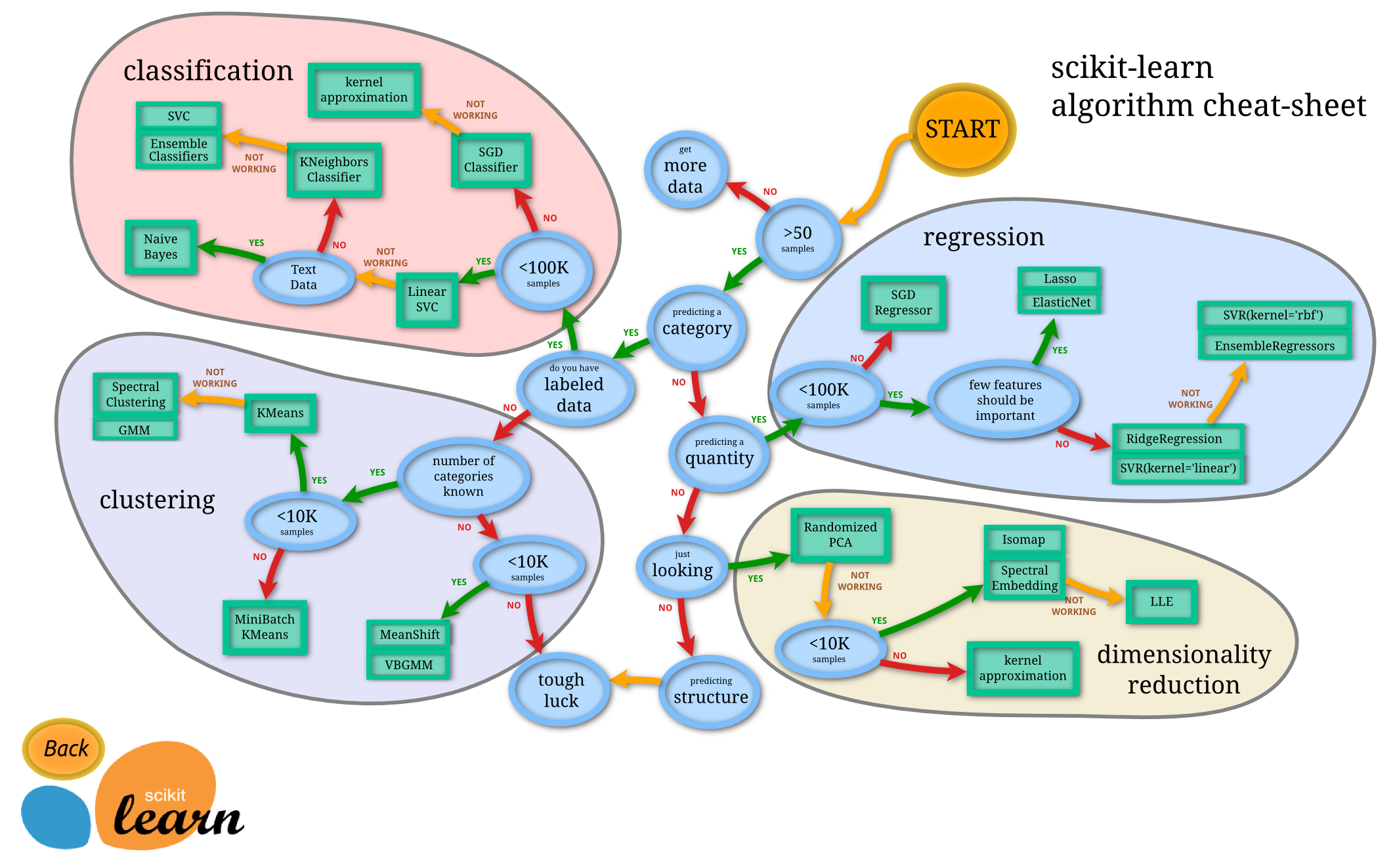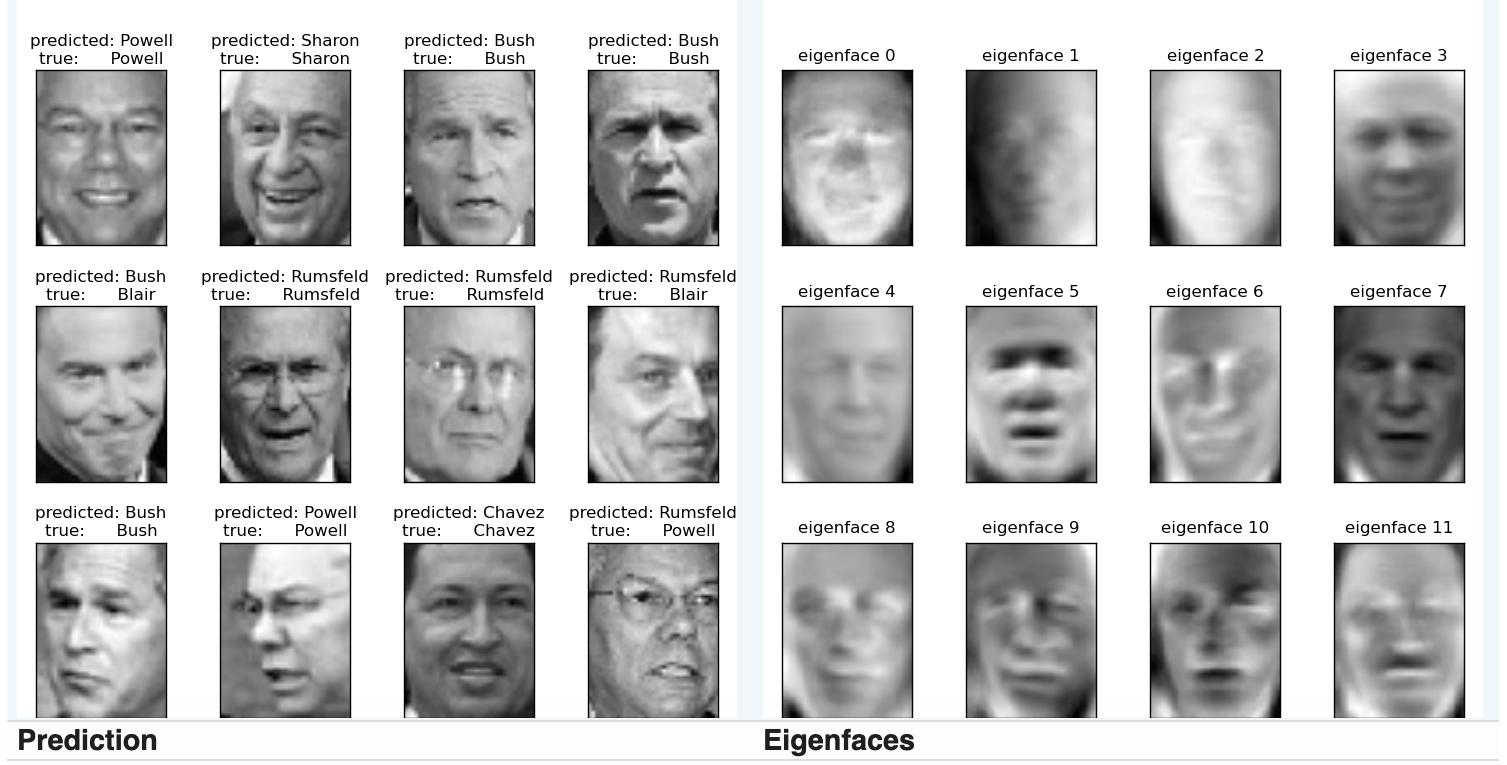目录
1. 机器学习简介
问题设置
- 考虑一系列数据,预测未知数据的属性
- 样本是多个属性的数据,则说有许多属性或者特征
- 监督学习:数据带有想要预测的结果值属性
- 分类
- 回归
- 无监督学习:数据是没有任何目标值的一组输入向量组成
- 聚类:发现数据中彼此类似的示例
- 密度估计:确定输入空间内的数据分布
- 降维:将高维数据投射到二维或者三位进行可视化
- 训练集:从中学习数据的属性
- 测试集:测试学习到的性质
加载示例数据集
具体参考sklearn: 数据集加载
>>> from sklearn import datasets
>>> iris = datasets.load_iris()
>>> digits = datasets.load_digits()
>>> print(digits.data)
>>> digits.target
学习和预测
- 基于训练数据,拟合一个估计器,预测未知的数据所属类别
>>> from sklearn import svm
# 设置
>>> clf = svm.SVC(gamma=0.001, C=100.)
# 学习
>>> clf.fit(digits.data[:-1], digits.target[:-1])
# 预测
>>> clf.predict(digits.data[-1:])
模型保存和加载
>>> import pickle
# 保存
>>> s = pickle.dumps(clf)
# 重新加载
>>> clf2 = pickle.loads(s)
# 预测新数据
>>> clf2.predict(X[0:1])
array([0])
>>> y[0]
0
再次训练和更新参数
- 同一个估计器,如果多次被调用,超参数存在更新,那么训练的到的模型也会被更新
>>> import numpy as np
>>> from sklearn.datasets import load_iris
>>> from sklearn.svm import SVC
>>> X, y = load_iris(return_X_y=True)
# 第一次训练,得到一个模型
>>> clf = SVC()
>>> clf.set_params(kernel='linear').fit(X, y)
SVC(C=1.0, cache_size=200, class_weight=None, coef0=0.0,
decision_function_shape='ovr', degree=3, gamma='auto_deprecated',
kernel='linear', max_iter=-1, probability=False, random_state=None,
shrinking=True, tol=0.001, verbose=False)
>>> clf.predict(X[:5])
array([0, 0, 0, 0, 0])
# 第二次训练,得到一个模型
# 直接指定模型需要更改的超参数
>>> clf.set_params(kernel='rbf', gamma='scale').fit(X, y)
SVC(C=1.0, cache_size=200, class_weight=None, coef0=0.0,
decision_function_shape='ovr', degree=3, gamma='scale', kernel='rbf',
max_iter=-1, probability=False, random_state=None, shrinking=True,
tol=0.001, verbose=False)
>>> clf.predict(X[:5])
array([0, 0, 0, 0, 0])
多分类和多标签拟合
如果预测的y是属于多类别的,比如有0,1,2三种类别,有两种方式进行预测:
- 一种是直接预测类别,输出为0,1,2其中的一个(也就是一种类别)
- 一种是先对y进行二值化(one-hot),比如这里就是一个1x3的数组
>>> from sklearn.svm import SVC
>>> from sklearn.multiclass import OneVsRestClassifier
>>> from sklearn.preprocessing import LabelBinarizer
# 直接预测,每个样本是某一类
>>> X = [[1, 2], [2, 4], [4, 5], [3, 2], [3, 1]]
>>> y = [0, 0, 1, 1, 2]
# 先对y进行二值化编码,预测值是二值编码的形式
>>> classif = OneVsRestClassifier(estimator=SVC(random_state=0))
>>> classif.fit(X, y).predict(X)
array([0, 0, 1, 1, 2])
>>> y = LabelBinarizer().fit_transform(y)
>>> classif.fit(X, y).predict(X)
array([[1, 0, 0],
[1, 0, 0],
[0, 1, 0],
[0, 0, 0], # 这里为0,表示预测的结果不匹配训练集合的任一标签
[0, 0, 0]])
类似的,多标签的(一个样本属于多个类别,比如一个图片同时包含猫和狗)也可以先对y进行标签化,再训练预测:
>> from sklearn.preprocessing import MultiLabelBinarizer
>> y = [[0, 1], [0, 2], [1, 3], [0, 2, 3], [2, 4]]
>> y = MultiLabelBinarizer().fit_transform(y)
>> classif.fit(X, y).predict(X)
array([[1, 1, 0, 0, 0],
[1, 0, 1, 0, 0],
[0, 1, 0, 1, 0],
[1, 0, 1, 1, 0],
[0, 0, 1, 0, 1]])
# 这里有0-4共5个类别,所以是一个1x5的数组
# 如果某个样本属于多个类别,相应类别值为1
2. 统计学习:监督学习
k近邻分类器
维度惩罚(curse of dimensionality)
- 高维情形下出现的数据样本稀疏,距离计算困难(算法的空间可能复杂度指数上升)等问题
- 解决方法一般是降维和特征选择,常见的降维方法有PCA,embedding等
线性回归
- 最简单的拟合线性模型形式,是通过调整数据集的一系列参数令残差平方和尽可能小
稀疏
分类
支持向量机
- 判别模型
- 找到样例的一个组合来构建一个两类之间最大化的平面
- 参数C:正则化
使用核
- 特征空间内,数据不总是线性可分的
- 多项式或者非线性的进行拟合
3. 统计学习:模型选择
交叉验证
网格搜索
4. 统计学习:无监督学习
聚类
- kmeans聚类:结果不能完全对应真实情况
- 合适的聚类数量难以选取
- 初始化值的敏感性,陷入局部最优
分层聚类:慎用
- Agglomerative(聚合) - 自底向上的方法: 初始阶段,每一个样本将自己作为单独的一个簇,聚类的簇以最小化距离的标准进行迭代聚合。当感兴趣的簇只有少量的样本时,该方法是很合适的。如果需要聚类的 簇数量很大,该方法比K_means算法的计算效率也更高。
- Divisive(分裂) - 自顶向下的方法: 初始阶段,所有的样本是一个簇,当一个簇下移时,它被迭代的进 行分裂。当估计聚类簇数量较大的数据时,该算法不仅效率低(由于样本始于一个簇,需要被递归的进行 分裂),而且从统计学的角度来讲也是不合适的。
特征聚集
- 合并相似的维度(特征)
分解:PCA、ICA
- 提取数据的主要成分
5. 利用管道把所有的放在一起
这个是使用面部特征进行人脸识别的例子:
"""
===================================================
Faces recognition example using eigenfaces and SVMs
===================================================
The dataset used in this example is a preprocessed excerpt of the
"Labeled Faces in the Wild", aka LFW_:
http://vis-www.cs.umass.edu/lfw/lfw-funneled.tgz (233MB)
.. _LFW: http://vis-www.cs.umass.edu/lfw/
Expected results for the top 5 most represented people in the dataset:
================== ============ ======= ========== =======
precision recall f1-score support
================== ============ ======= ========== =======
Ariel Sharon 0.67 0.92 0.77 13
Colin Powell 0.75 0.78 0.76 60
Donald Rumsfeld 0.78 0.67 0.72 27
George W Bush 0.86 0.86 0.86 146
Gerhard Schroeder 0.76 0.76 0.76 25
Hugo Chavez 0.67 0.67 0.67 15
Tony Blair 0.81 0.69 0.75 36
avg / total 0.80 0.80 0.80 322
================== ============ ======= ========== =======
"""
from time import time
import logging
import matplotlib.pyplot as plt
from sklearn.model_selection import train_test_split
from sklearn.model_selection import GridSearchCV
from sklearn.datasets import fetch_lfw_people
from sklearn.metrics import classification_report
from sklearn.metrics import confusion_matrix
from sklearn.decomposition import PCA
from sklearn.svm import SVC
print(__doc__)
# Display progress logs on stdout
logging.basicConfig(level=logging.INFO, format='%(asctime)s %(message)s')
# #############################################################################
# Download the data, if not already on disk and load it as numpy arrays
lfw_people = fetch_lfw_people(min_faces_per_person=70, resize=0.4)
# introspect the images arrays to find the shapes (for plotting)
n_samples, h, w = lfw_people.images.shape
# for machine learning we use the 2 data directly (as relative pixel
# positions info is ignored by this model)
X = lfw_people.data
n_features = X.shape[1]
# the label to predict is the id of the person
y = lfw_people.target
target_names = lfw_people.target_names
n_classes = target_names.shape[0]
print("Total dataset size:")
print("n_samples: %d" % n_samples)
print("n_features: %d" % n_features)
print("n_classes: %d" % n_classes)
# #############################################################################
# Split into a training set and a test set using a stratified k fold
# split into a training and testing set
X_train, X_test, y_train, y_test = train_test_split(
X, y, test_size=0.25, random_state=42)
# #############################################################################
# Compute a PCA (eigenfaces) on the face dataset (treated as unlabeled
# dataset): unsupervised feature extraction / dimensionality reduction
n_components = 150
print("Extracting the top %d eigenfaces from %d faces"
% (n_components, X_train.shape[0]))
t0 = time()
pca = PCA(n_components=n_components, svd_solver='randomized',
whiten=True).fit(X_train)
print("done in %0.3fs" % (time() - t0))
eigenfaces = pca.components_.reshape((n_components, h, w))
print("Projecting the input data on the eigenfaces orthonormal basis")
t0 = time()
X_train_pca = pca.transform(X_train)
X_test_pca = pca.transform(X_test)
print("done in %0.3fs" % (time() - t0))
# #############################################################################
# Train a SVM classification model
print("Fitting the classifier to the training set")
t0 = time()
param_grid = {'C': [1e3, 5e3, 1e4, 5e4, 1e5],
'gamma': [0.0001, 0.0005, 0.001, 0.005, 0.01, 0.1], }
clf = GridSearchCV(SVC(kernel='rbf', class_weight='balanced'),
param_grid, cv=5, iid=False)
clf = clf.fit(X_train_pca, y_train)
print("done in %0.3fs" % (time() - t0))
print("Best estimator found by grid search:")
print(clf.best_estimator_)
# #############################################################################
# Quantitative evaluation of the model quality on the test set
print("Predicting people's names on the test set")
t0 = time()
y_pred = clf.predict(X_test_pca)
print("done in %0.3fs" % (time() - t0))
print(classification_report(y_test, y_pred, target_names=target_names))
print(confusion_matrix(y_test, y_pred, labels=range(n_classes)))
# #############################################################################
# Qualitative evaluation of the predictions using matplotlib
def plot_gallery(images, titles, h, w, n_row=3, n_col=4):
"""Helper function to plot a gallery of portraits"""
plt.figure(figsize=(1.8 * n_col, 2.4 * n_row))
plt.subplots_adjust(bottom=0, left=.01, right=.99, top=.90, hspace=.35)
for i in range(n_row * n_col):
plt.subplot(n_row, n_col, i + 1)
plt.imshow(images[i].reshape((h, w)), cmap=plt.cm.gray)
plt.title(titles[i], size=12)
plt.xticks(())
plt.yticks(())
# plot the result of the prediction on a portion of the test set
def title(y_pred, y_test, target_names, i):
pred_name = target_names[y_pred[i]].rsplit(' ', 1)[-1]
true_name = target_names[y_test[i]].rsplit(' ', 1)[-1]
return 'predicted: %s\ntrue: %s' % (pred_name, true_name)
prediction_titles = [title(y_pred, y_test, target_names, i)
for i in range(y_pred.shape[0])]
plot_gallery(X_test, prediction_titles, h, w)
# plot the gallery of the most significative eigenfaces
eigenface_titles = ["eigenface %d" % i for i in range(eigenfaces.shape[0])]
plot_gallery(eigenfaces, eigenface_titles, h, w)
plt.show()
6. 正确选择评估器

参考
If you link this blog, please refer to this page, thanks!
Post link:https://tsinghua-gongjing.github.io/posts/sklearn_tutorials.html
Previous:
Python module pytorch
Next:
Softmax function
Latest articles
Links
- ZhangLab , RISE database , THU life , THU info
- Data analysis: pandas , numpy , scipy
- ML/DL: sklearn , sklearn(中文) , pytorch
- Visualization: seaborn , matplotlib , gallery
- Github: me
